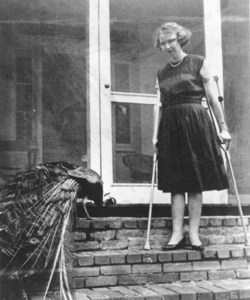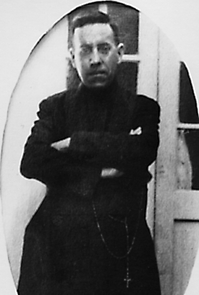Blessed Miguel’s biography
Christ the King, Solemnity
He is King of hearts, too, by reason of his “charity
which exceedeth all knowledge.” And his mercy and kindness which draw
all
men to him, for never has it been known, nor will it ever be, that man be loved
so much and so universally as Jesus Christ.
-Pope Pius XI, December 11, 1925,
Qua Primas
CS Lewis: gone 46 years
A priest’s obedience = remaining in truth, says Archbishop Piacenza
Obedience is part of everyone’s human experience. Right now I can’t think of anyone on the planet who is not called/bound to some type of obedience. Can you? In the Catholic priesthood the man being ordained a priest makes a promise of respect and obedience to the bishop (if the man is going to be a diocesan priest), for life. How counter-cultural that is! In a regular letter to those interested, the secretary at the Congregation for Clergy has been writing periodic letters exploring various themes in the priesthood because we are in the “Year for Priests.” Today’s reflection is on priestly obedience.
obedience, ordinands profess a “promise” of “filial respect and obedience” to
their own Ordinary and his Successors. If the theological standing of a Vow and
a promise is different, the total and definitive moral obligation is identical,
and likewise identical is the offering of one’s will to the will of Another: to
the Divine will, mediated through the Church.
it is by relativism and democraticism, by various forms of autonomous
individualism and libertinism, such a promise of obedience appears ever more
incomprehensible to the prevailing mindset. It is not rare for it to be
conceived as a diminution of dignity and human freedom, as a perseverance in obsolete
forms, typical of a society incapable of authentic emancipation.
authentic obedience know well that this is not the case. Obedience in the
Church is never contrary to the dignity and respect of the person, nor must it
ever be understood as an abandonment of responsibility or as a surrender. The
Rite utilizes a fundamental adjective for the right understanding of such a
promise; it defines obedience only after mentioning “respect”, and this with
the adjective “filial”. Now the term “son”, in every language, is a relative
name, which implies, specifically, the relationship of a father and a son. It
is in this context that the obedience we have promised must be understood. It
is a context in which the father is called to truly be a father, and the son to
recognize his own sonship and the beauty of the fatherhood that has been given
to him. As happens in the law of nature, no one chooses his own father, nor
does one choose one’s own sons. Therefore, we are all called, fathers and sons,
to have a supernatural regard for one another, one of great reciprocal clemency
and respect, that is to say the capacity to look at the other keeping always in
mind the good Teacher who has brought him into being, and who always,
ultimately, moulds him. Respect
is, by definition, simply this: to look at someone while keeping Another in
mind!
is possible, one which is not only formal, a mere execution of orders, but one
which is ardent, complete, attentive, which can really bring forth the fruits
of conversion and of “new life” in him who lives it.
Ordinary at the time of ordination and to his “Successors”, since the Church
always draws back from an excessive personalism: She has at heart the person,
but not the subjectivism that detracts from the power and the beauty, both
historical and theological, which characterize the Institution of obedience.
The Spirit resides also in the Institution, since it is of divine origin. The
Institution is charismatic, of its very nature, and thus to be freely bound by
it in time (the Successors) means to “remain in the truth”, to persevere in
Him, present and operative in his living body, the Church, in the beauty of the
continuity of time, of ages, which joins us enduringly to Christ and to his
Apostles.
Blessed Frances Siedliska (Mary of Jesus the Good Shepherd)
 Come bride of Christ, and receive the crown, which the Lord has prepared for you for ever.
Come bride of Christ, and receive the crown, which the Lord has prepared for you for ever.
Flannery O’Connor: the only great Christian writer in the US
 Encountering the grace through the literature is a sufficient way of knowing Christ and the fruitfulness of the Gospel. For many, myself included, Mary Flannery O’Connor is wonderful entree into the Mystery of God. Watch the story, I think you’d surprised by what you’d learn.
Encountering the grace through the literature is a sufficient way of knowing Christ and the fruitfulness of the Gospel. For many, myself included, Mary Flannery O’Connor is wonderful entree into the Mystery of God. Watch the story, I think you’d surprised by what you’d learn.
The Black Nobility and the Pope
 Bet you didn’t know the Church had black nobility. Do you know the difference between the white and the black nobility? Not many good Catholics can anymore. AND certainly not many on this side of the pond. For most Americans the idea of nobility is foolish. Especially given our history of rejecting the monarchy. American interest in things monarchical is kept to a quiet interest in Britain’s queen and perhaps to one or two other royal personages of northern Europe. And if you watch 60 Minutes you’d be familiar with the Sultan in Bahrain.
Bet you didn’t know the Church had black nobility. Do you know the difference between the white and the black nobility? Not many good Catholics can anymore. AND certainly not many on this side of the pond. For most Americans the idea of nobility is foolish. Especially given our history of rejecting the monarchy. American interest in things monarchical is kept to a quiet interest in Britain’s queen and perhaps to one or two other royal personages of northern Europe. And if you watch 60 Minutes you’d be familiar with the Sultan in Bahrain.
Not Squandering illness: Terminally ill priest meets with Pope, offers sufferings for the Church
The Catholic News Agency ran this brief article yesterday (11/19/2009).
It captured my mind and heart, like it did for others, because I know two
people with Lou Gehrig’s disease (and one is also a priest) and another priest
who’s living with MS. The courage, love and patience these men have witnessed
is incredible. At least I think so.
Father Luigi
Squarcia, a pastor in the Italian town of Acquapendente who has suffered from
Lou Gehrig’s disease for the last four years, met with Pope Benedict XVI on
Wednesday and offered his “sufferings for the good of the Church.”
After the
meeting with the Holy Father in Paul VI Hall, Father Squarcia said, “I came to offer
the Pope my sufferings for the good of the Church. I am here, for the
first time, after years of working with the parishioners and the children at
our school.”
Now, he told L’Osservatore Romano, “I can no longer move my arms
or legs and I know I will lose my speech and later maybe the ability to
breathe.” He noted that more people than ever are coming to him for the
Sacrament of Reconciliation.
Lou Gehrig’s disease is a serious neuromuscular
disorder that causes muscle weakness, disability and eventually death.
*Father Luigi in a 2004 photo.
If you
want a keener sense of what Father Luigi is speaking of when he says I am came
offer my sufferings for the Church, then I would suggest you read Pope John Paul II’s 1984 encyclical, Salvifici
Doloris, where he deals with notions of suffering and how it can be redemptive. That is, how suffering can be useful for the salvation of the work if we unite
our suffering to that of Christ’s. Putting suffering to good use otherwise it will eat you alive and deaden you affectively and spiritually. If not redemptive then it’s all-consuming and verging on nihilistic.
Saint Agnes of Assisi
God, our Father, You made Saint Agnes an example of seraphic perfection for many virgins. Grant that we may imitate her virtues on earth and with her possess eternal joys.
Considered a co-foundress of the Poor Clares with Saint Clare, Saint Agnes of Assisi died three months after Clare. And like Clare, Saint Agnes was an abbess but of a group of former Benedictine nuns. On some calendars Saint Agnes of Assisi is commemorated on November 16, but she is commemorated today on the current ordo of the Franciscans.





